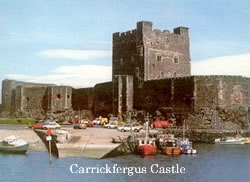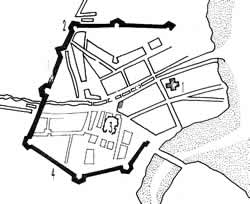King William in Ulster
Twelve
Days in June
King William was in Ulster from Saturday, June 14, 1690 until
Thursday, June 26, only 12 days, yet he left behind a legend
full of proud memories. For his part he liked what he saw.
"This country is worth fighting for," he said.
His departure from London had been held up by parliamentary
business till the end of May, when he announced that he could
wait no longer and adjourned Parliament.
Early in the morning of June 4 he set out, reaching Northampton
before night fall. On Sunday June 8 he attended divine service
in Chester Cathedral and went on to inspect the ships at Hoylake
on the tip of the Worral Peninsula.
For two days the wind was contrary, but on June 11 he embarked
on board the yacht "Mary" with a fleet escorted
by Sir Cloudesley Shovell's squadron. On June 14 the hills
of Ireland came in sight and in the afternoon the fleet cast
anchor  off
Carrickfergus. He was rowed ashore in the Rear Admiral's barge
and at about 3.30 p.m. landed at the Old Quay under the shadow
of the great Norman Castle. off
Carrickfergus. He was rowed ashore in the Rear Admiral's barge
and at about 3.30 p.m. landed at the Old Quay under the shadow
of the great Norman Castle.
The Garrison of the Castle had drawn
up a Guard of Honour and the townspeople added their applause.
The chosen spokesman was a Quaker, whose principles forebade
him to doff his hat, or use such titles as Sir and Majesty.
He got over the difficulty by taking off his hat and laying
it on a stone and then stepping forward and saying "William,
thou art welcome to thy Kingdom" which pleased the King
so much that he replied: "you are the best bred gentleman
I have met since I came to England."
With these words he mounted his horse and set off for Belfast.
Half-way along the shore was the little port of Whitehouse,
where most of the army disembarked. The Commander-in-Chief,
the Duke of Schomberg, and his senior commanders were waiting
here to welcome the King.
To cover the disembarkation, earthworks has been thrown up
by the engineers at Fort William and garrisoned by troops
ready for action.
In 1690 Belfast consisted of about 300 houses in five streets.
It had two churches, the Parish Church, where St. George's
still stands in the High Street, and the Presbyterian Meeting
House in Rosemary Lane. The town had been surrounded by a
rampart in 1642 and had been captured by Colonel Venebles
for Cromwell after a four-day siege and an assault on the
North Gate in 1649.
Town
Plan of Belfast 1690

1. Parish Church 2. North Gate 3. Castle 4.
Rampart
It was at the North Gate that King William entered Belfast
where North Street now crosses Royal Avenue. Here he was welcomed
by the magistrates and burgesses in their robes and by the
Rev. George Walker, now Bishop-elect of Derry.
A Royal Salute was fired from the Castle and was echoed and
re-echoed by the guns which Schomberg had placed at wide intervals
for the purpose of conveying signals from post to post. Wherever
it was heard it was known that King William had come. Before
midnight all the heights of Antrim and Down were blazing with
bonfires.
The next day being Sunday he attended Church at the Corporation
Church, now St. George's and heard chaplain, Rev. G. Royce,
preach from the text: "Who through Faith subdued kingdoms"
- Hebrews 11.33. He finished prophetically: "When thou
passest through the waters I will be with thee" (Isaiah
43.2).
Next day, Monday June 16, addresses of loyalty were presented
on behalf of the Church of Ireland and Presbyterian Church
clergy, the civic authorities of the city of Londonderry,
the town of Belfast and by the Sheriffs, Justices of the Peace
and Gentlemen of the Counties of Down and Antrim. The next
two days were spent in military preparation.
Lieut. General James Douglas arrived from Scotland, with
a consignment of arms and ammunition and was able to make
a good report of how matters stood North of the Tweed.
In the previous season Schomberg had conducted a slow and
cautious campaign but William said he had not come to Ireland
to let the grass grow under his feet. He ordered a general
muster of the army in the Parish of Aghaderg which included
Scarvagh and on Thursday June 19 began his southward march
from Belfast Castle.
The line of march continued along Upper Malone by the Old
Coach Road and past the ruins of both Drumbeg and Lambeg Parish
Churches which had been burnt down in 1641.
William reached Schomberg's headquarters in Lisburn Castle
for lunch on the same day that he left Belfast Castle. The
afternoon and evening were spent inspecting troops on Blaris
Moor, and then on to Hillsborough Castle for the night.
The cavalcade moved on through the little round hills of
Co. Down, crossed the Upper Bann between Huntly and Ballievey
by ford over the hill of Banbridge and on to the rendezvous
on the north west of Loughbrickland.
Dr. Michael Dewar in "The Scarva Story" quotes
Lewis Topographical Dictionary, 1837 under Scarvagh: "Here
the army of William III first rendezvoused after landing in
Ireland, the camp extended in two lines from Loughbrickland
to Scarvagh Pass and Pointz Pass. A venerable oak in Scarvagh
Demesne is still shown as that under which the royal tent
was pitched.
"Actually it is a Spanish Chestnut, but the lines stretching
in two directions explain how King William's tent came to
be pitched between the two arcs of his encampment, and how
Scarva was privileged to shelter the King himself."
After the disappointments of the previous season and the
appalling loss of life through disease, Schomberg had dispersed
his army into winter quarters all over Ulster. The Derry and
Enniskillen men had gone home to pick up the threads of their
lives. Now the farmers among them had the crop in and were
recalled to the colours and ready to be reviewed. There were
four regiments of Enniskillen men - Wynns, Tiffins, Lloyds
and Cunninghams, one of foot and three of horse. There was
only one regiment of Derry men, St. John's, commanded by Mitchelburne
with Rev. George Walker as chaplain.
Story describes the Inniskillen Dragoons of the time: "The
sight of their thin little nags and the wretched dress of
their riders, half naked with sabre and pistols hanging from
their belts, looked like a horde of tartars.
"The Enniskilleners were without uniforms for even when
they were supplied with them, they preferred to fight in their
shirt sleeves. This was such a contrast to Schomberg's strict
discipline, that he made an exception and let them go according
to their own genius."
On June 22, King William sat in the saddle for hours reviewing
his 36,000 men. Marching past were 10,000 Danes, some of whom
came from Norway and Sweden, and even Finland, 7,000 Dutch
and Brandenburgers, 2,000 French Huguenots, 11,000 English
and Scots , 800 Derrymen, 4,500 Inniskilleners and two companies
from Bandon in Cork
On June 24, an advance party reached beyond Newry to the
edge of Dundalk and brought intelligence that James had fallen
back on Ardee. On June 25, the main army advanced to Newry
and camped on the side of a hill. The next day, with the King
at their head, wearing an Orange colour sash, they went through
the Moyry Gap and passed out of Ulster en route to the Boyne.
Back to History Home Page
|

 off
Carrickfergus. He was rowed ashore in the Rear Admiral's barge
and at about 3.30 p.m. landed at the Old Quay under the shadow
of the great Norman Castle.
off
Carrickfergus. He was rowed ashore in the Rear Admiral's barge
and at about 3.30 p.m. landed at the Old Quay under the shadow
of the great Norman Castle.